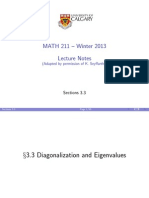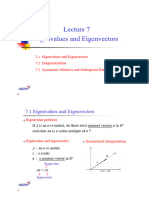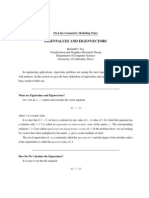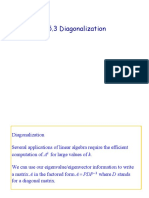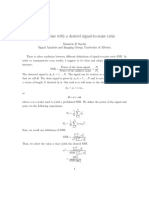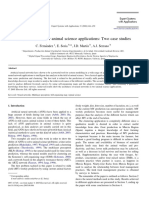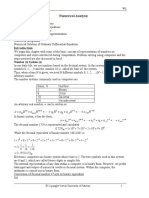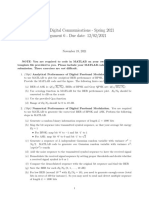1 EIGENVALUES AND EIGEN-
VECTORS
Objectives
By the end of this topic, you will be able to:
compute eigenvalues and eigenvectors of square matrices.
diagonalize matrices.
perform orthogonal diagonalization of symmetric matrices.
Main Reference:Schaum’s outline Linear Algebra 4th edition, chapter 9.
1.1 Eigenvalues and Eigenvectors
Definition:
Let A be a square matrix. The real number λ is called eigenvalue of A if ∃
a nonzero vector x such that,
Ax = λx
x is called the eigenvector of A.
Examples: ! !
3 0 1
#1. Let A = ; x= & λ = 3.
8 −1 2
Show that Ax = λx.
! !
4 −2 2
#2. Let A = & x= .
1 1 1
Find the eigenvalue of A.
1.2 Real Life Applications
i) System of Communication: Eigenvalues are used to calculate the theo-
retical limit of how much information can be carried via a communica-
1
� tion channel such as a telephone line or the air. The eigenvectors and
eigenvalues of the communication channel (represented as a matrix)
are calculated, and then the eigenvalues are water-filled. The eigenval-
ues are then essentially the gains of the channel’s fundamental modes,
which are recorded by the eigenvectors.
ii) Bridge Construction: The smallest magnitude eigenvalue of a system
that models the bridge is the natural frequency of the bridge. Engineers
use this knowledge to guarantee that their structures are stable.
iii) Automobile Stereo System Design: Eigenvalue analysis is also employed
in the design of car stereo systems, where it aids in the reproduction
of car vibration caused by music.
iv) Electrical and Mechanical Engineering: The use of eigenvalues and
eigenvectors to decouple three-phase systems via symmetrical compo-
nent transformation is advantageous.
v) In Statistics: Computing CIs, PCA and Factor Analyses, Matrix Fac-
torization, LS Approximations etc.
1.3 Algebraic Eigenvalue Problem
To find the eigenvalues of a square matrix A, we rewrite the equation Ax = λx
as Ax = λIx.
=⇒ (λI − A)x = 0 OR (A − λI) = 0
This system has a non trivial solution iff
det(λI − A) = 0 OR det(A − λI) = 0
The equation det(λI − A) = 0 is called the characteristic equation of A and
it is expanded, its called the characteristic polynomial of A.
Examples:
#3. Find the eigenvalues of:
2
� ! !
3 0 3 2
i) A = ii) B = .
8 −1 −1 0
Hint: Solve | λI − A |= 0 and | λI − B |= 0
#4. For each eigenvalue above, find the associated eigenvectors of the ma-
trices.
#5. Find the eigenvalues and eigenvectors (for integer eigenvalues) of the
following
matrices
1 2 −1 0 1 0 5 6 2
i) A = 1 0
1 ii) B = 0 0 1
iii) C = 0 −1 −8
.
4 −4 5 4 −17 8 1 0 −2
Theorem:
If A is square matrix, the following are equivalent:
a) λ is the eigenvalue of A
b) (λI − A)x = 0 has nontrivial solutions
c) ∃ a nonzero vector x ∈ Rn such that Ax = λx
d) λ is a real solution to | λI − A |= 0.
The eigenvectors are the nonzero vectors in the solution space of (λI −A)x =
0. They are called eigenspace of A corresponding to
λ.
3 −2 0
#6. Compute the bases for the eigenspace of A = −2 3 0 .
0 0 5
Losung:
2
X-teristic eqn: | λI − A |= 0=⇒ (λ − 1)(λ
−5) =0;
∴ λ = 1, 5. Verify.
−s −1 0
For λ = 5: eigenvector x = s = s 1 + t 0.Work these out!
t 0 1
−1 0
Since
1 and 0 are LI, they form a basis for the eigenspace corre-
0 1
sponding to λ = 5.
3
�
t 1
Similarly for λ = 1 the eigenvector x =
t = t 1.
0 0
1
Hence 1
forms a basis corresponding to λ = 1.
0
EER: Check out relevant questions from Exercise Set 5.1 from the main
text above.
1.4 Diagonalization
Definition:
A matrix A is said to be diagonalizable if ∃ an invertible matrix P such that
P −1 AP is diagonal, the matrix!P is said to diagonalize
! A.
1 1 1 1
For example, if A = ; P = . Then D = P −1 AP =
−2 4 1 2
!
2 0
. Check it out!
0 3
Theorem:
If A is n × n and diagonalizable, then A has n LI eigenvectors.
1.4.1 Procedure for Diagonalizing Matrices
1) Find n LI eigenvectors of A, e.g {v1 , v2 , · · · , vn }
2) Form the matrix P having v1 , v2 , · · · , vn as its column vectors.
3) The matrix P −1 AP will then be diagonal with λ1 , λ2 , · · · , λn as its di-
agonal elements where λi is the eigenvalue corresponding to the eigen-
vector vi ∀ i
3 −2 0
#7. Find the matrix P that diagonalizes A =
−2 3 .
0
0 0 5
Losung:
4
�From an earlier example (#6 above), the eigenvalues ofA are λ =1, 5 and
1 0 −1
the eigenvectors form the column vectors of P, i.e P =
1 0 1 or any
0 1 0
similar arrangement of the eigenvectors of A.
Verify that D = P −1 AP is diagonal.
#8. EER: Find the matrix P that diagonalizes the matrices in example
5 (#5) above (for integer eigenvalues) and verify that the corresponding
P −1 AP are diagonal. !
−3 2
#9. Find the characteristic equation of A = and show that A is
−2 1
not diagonalizable.
Losung: Verify! | λI − A |= 0 =⇒ (λ + 1)2 = 0 =⇒ λ = −1.
Only one eigenvalue implying only one eigenvector (not two).
Hence A is not diagonalizable.
x1
#10. Let T : R3 3
→ R be a linear operator given by T
x2 =
x3
3x1 − 2x2
−2x1 + 3x2 .
5x3
Find a basis for R3 relative to which the matrix of T
is diagonal.
3 −2
Losung: Basis for R3 = (e1 , e2 , e3 ) ⇒ T (e1 ) = −2
; T (e2 ) = 3 & T (e3 ) =
0 0
0
0.
5
3 −2 0
Thus the standard matrix A for T is = −2 3 0
.
0 0 5
Change to a new basis, B = (u1 , u2 , u3 ) to obtain the diagonal matrix A′ for
′ ′ ′
5
�T . Ifthe transition
matrix P diagonalizes
A, then A′ = P −1 AP . From #7,
−1 0 1 5 0 0
′
P = 1 0 1 & A = 0 5 0.
0 1 0 0 0 1
The columns of P are [u′1 ]B , [u′2 ]B ; [u′3 ]B .
Thus,
−1
u′1 = (−1)e1 + (0)e2 + (0)e3 =
1
0
0
′
u2 = (0)e1 + (0)e2 + (1)e3 = 0
1
1
′
u3 = (1)e1 + (1)e2 + (0)e3 = 1
0
are the basis vectors that produce the diagonal matrix A′ .
Theorems:
a) If v1 , v2 , · · · , vn are eigenvectors corresponding to the distinct eigen-
values λ1 , λ2 , · · · , λn , then {v1 , v2 , · · · , vn } is a linearly independent
set.
b) If an n×n matrix A has n distinct eigenvalues, then A is diagonalizable.
EER:
−1 0 1
#11. Show that the matrix
−1 3 0 is not diagonalzable.
0 0 3
−1
#12. Find the matrix
P that diagonalizes A and hence fine P AP where
2 0 −2
A= 0 3 0 .
−4 13 −1
6
�
x1
#13. Let T : R3 → R3 be a linear operator given by T x2 =
x3
2x1 − x2 − x3
x1 − x3 .
−x1 + x2 + 2x3
Find a basis for R3 relative to which the matrix of T is diagonal.
1.5 Orthogonal Diagonalization
For a given linear operator; L : V → V , we wish to find an orthonor-
mal basis for V for which the matrix of L is diagonal. OR Alternatively,
given a square matrix A, we wish to find an orthogonal matrix P such
that P −1 AP = (P T AP ) is diagonal. (Note that for orthogonal matrix B,
B −1 = B T or BB T = I).
Definitions:
A square matrix A is called orthogonally diagonalizable if there is an
orthogonal matrix P s.t. P −1 AP (= P T AP ) is diagonal; the matrix P
is said to orthogonally diagonalze A.
A square matrix A is symmetric if A = AT .
For symmetric matrices, off diagonal elements are the ”same”. Give some
examples....
Theorem:
If A is symmetric, then eigenvectors from different eigenspaces are orthogo-
nal.
1.5.1 Procedure for Orthogonally Diagonalizing Symmetric Ma-
trix
1) Find a basis for each eigenspace of the matrix A.
2) Apply the Gram-Schmidt process to each basis to obtain an orthonor-
7
� mal basis for each eigenspae.
3) Form the matrix P whose columns are the orthonormal basis. P or-
thogonally diagonalizes A.
4 2 2
#14. Find an orthogonal matrix P that diagonalizes A =
2 4 2.
2 2 4
Losung:
Find eigenvalues of A, i.e |
λI − (λ −2)2 (λ − 8) = 0. ∴ λ = 2, 8.
A |= 0 =⇒
−1 −1
Eigenvectors: λ = 2, u1 = 1 ; u2 = 0 . Verify! u1 & u2 form a
0 1
basis.
Applying Gram-Schmidt process to u1 and u2 to obtain orthonormal bases
v1 and v2 :
−1
−1 √
u1 1 12
v1 = = √ 1 = √
||u1 || 2 2
0 0
−1
√
u2 − < u2 , v1 > v1 6
−1
v2 = = √
|| u2 − < u2 , v1 > v1 || 6
√2
6
−1
2
Note that < u2 , v1 >= u2 .v1 and u2 − < u2 , v1 > v1 = − 1 ; verify.
2
0
1
For λ = 8, the basis is u3 =
1 (verify.
1
Gram-Schmidt on u3 :
1
u3 1
v3 = =√ 1
||u3 || 3
1
8
�The matrix P is made up columns of v1 , v2 , v3 i.e
−1
√ −1
√ √1
2 6 3
1 −1 √1 ⊡
P =
√2 √
6 3
0 √2 √1
6 3
EER: Verify that P T AP is diagonal.
Theorems:
a) The characteristic equation of a symmetric matrix A has only real roots.
b) If an eigenvalue λ of a symmetric matrix A is repeated k times as a
root to the characteristic equation, then the eigenspace corresponding
to λ is k− dimensional.
EER:
#15. Find the dimensions of the eigenspaces of the following symmetric
matrices:
10
− 43 0 − 43
1 1 1 34
− 53 1
− 3 0 3
i) A = 1 1 1; λ = 0(2D), 3(1D) ii) B =
;
0 0 −2 0
1 1 1
− 34 1
3
5
0 −3
λ = −2(3D), 4(1D)
#16. Find a matrix P which orthogonally diagonalizes A and determine
P T AP : ! !
√1 −1
3 1 √
i) A = ; P= 2 2
; P T AP =??
1 3 √1 √1
2 2
1 1 0 √1 √1 0
2 2
ii) A = 1 1 0 √1 −1 P T AP =??
; P= √
;
0
2 2
0 0 0 0 0 1
9
�
3 1 0 0 0 0 √1 √1
2 2
√1 −1
1 3 0 0 0 0 √
iii) A =
; P= 2 2 ; P T AP =??
0 0 0 0
1 0
0 0
0 0 0 0 0 1 0 0
GOOD LUCK in your end of Semester Exams
10







